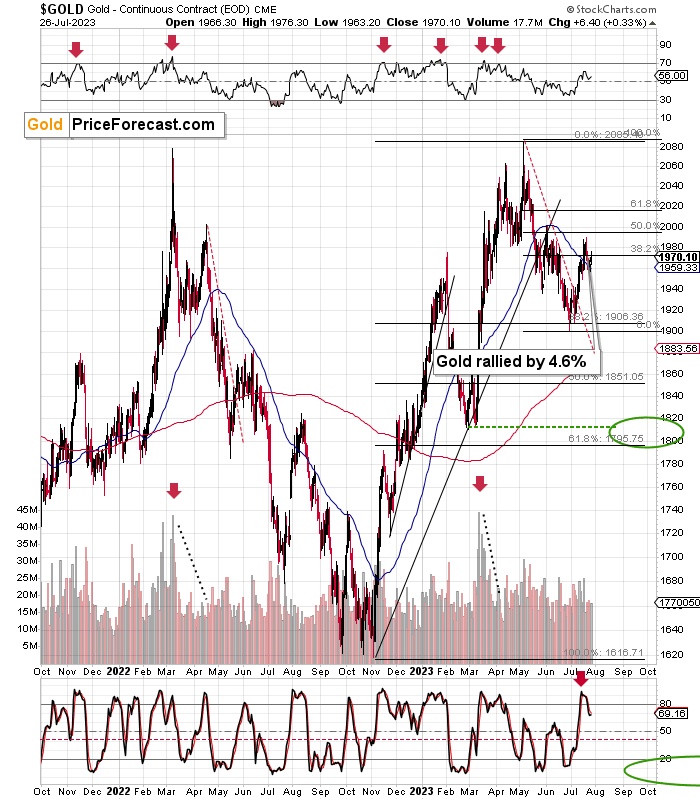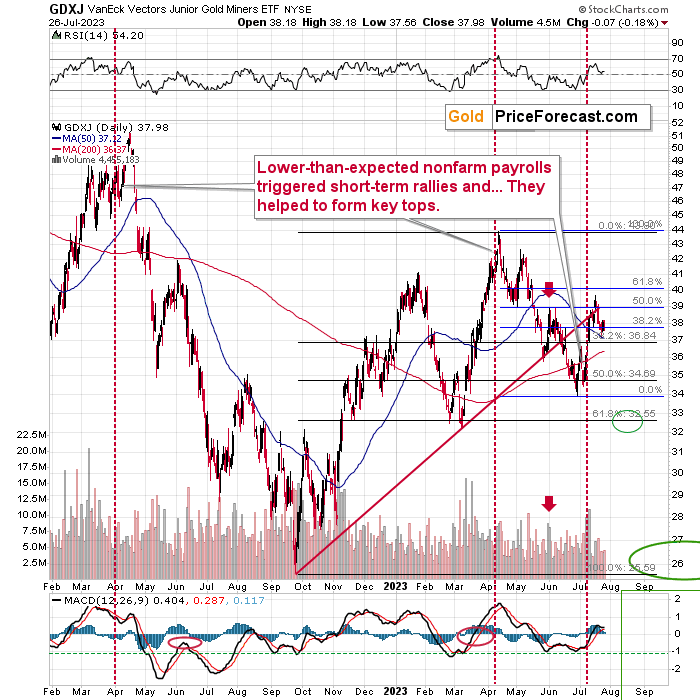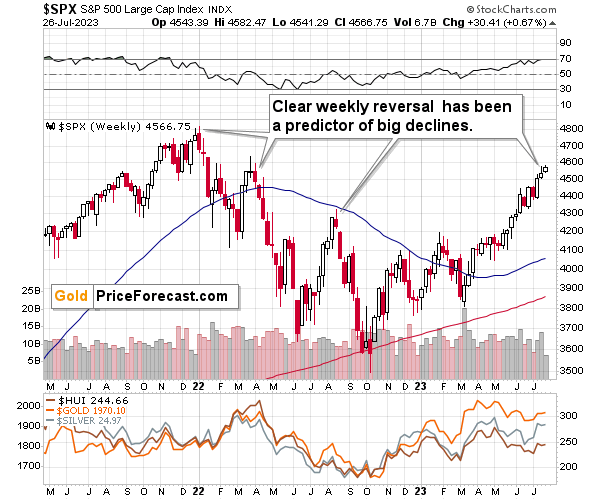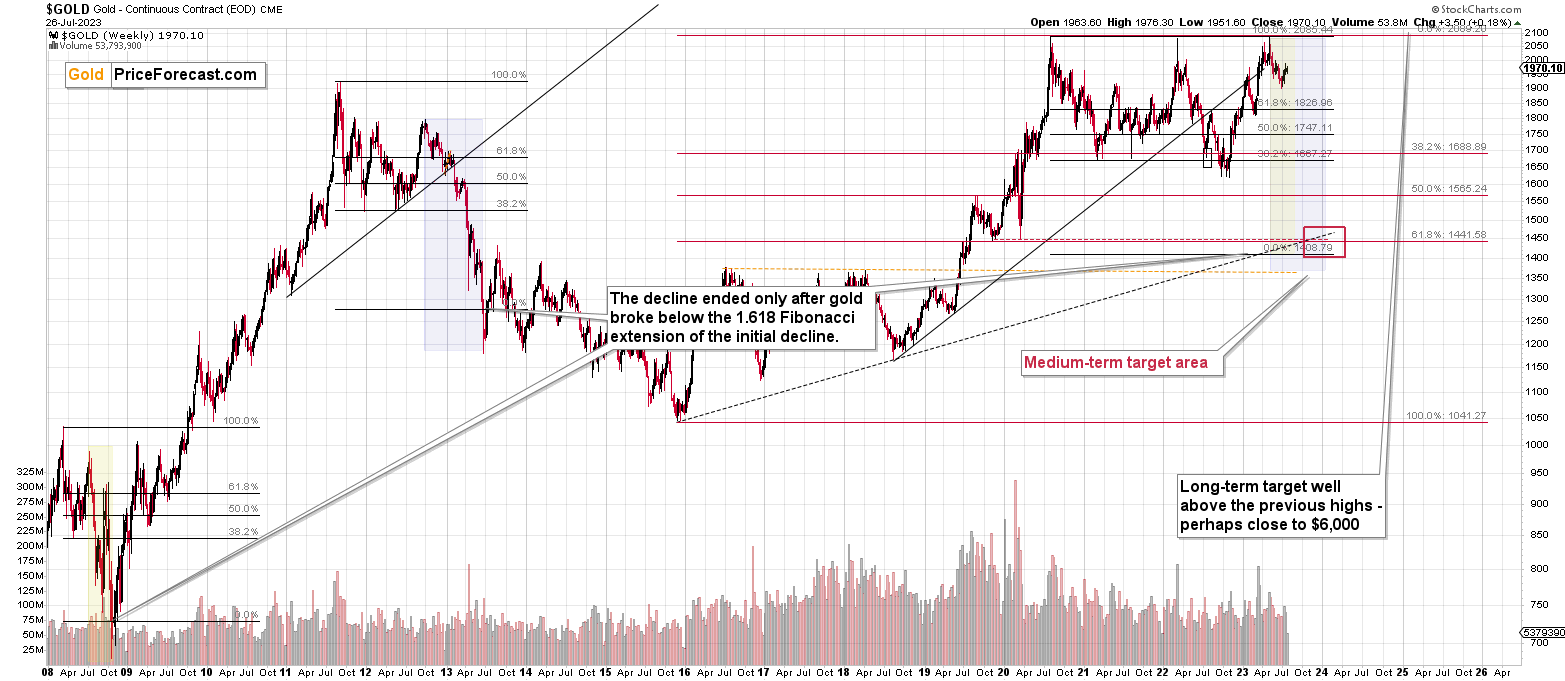Briefly: in our opinion, full (300% of the regular position size) speculative short positions in junior mining stocks are justified from the risk/reward point of view at the moment of publishing this Alert.
Some might consider an additional (short) position in the FCX.
Every market corrects from time to time, but sometimes those corrections are really the start of new, big moves. How to tell the difference?
As always, there are no certainties in any market, so the only thing that we can get is a greater chance of being right. And the odds for that increase as we get more context about a specific situation. The odds increase even more if the context that we get already caused similar reactions many times in the past.
Fortunately, we have this kind of reliable context in the case of the precious metals market and the current situation in it.
Here’s what the gold price did yesterday.
It was up by $6.40. That wasn’t significant on its own and it didn’t even invalidate the sell signal from the Stochastic indicator.
And it’s not the move in gold by itself that’s important. What’s important is how gold stocks reacted to it.
They should have moved higher as well.
But they didn’t. Instead, they moved lower yesterday. That was a daily decline by just 7 cents, but still, given gold’s upswing, miners should have rallied, so even a tiny rally here could be viewed as something bearish. The decline, however small, in this case, is a clear bearish indication.
This is something that we saw working many times in the past as a good indication that “down”, not “up”, was the true direction in which the precious metals market was heading.
And we’re seeing it all over again.
The USD Index moved a bit lower yesterday, but it’s not really important given that it had already invalidated its move to new 2023 lows, thus flashing a powerful buy signal.
This means that neither yesterday’s move lower nor today’s pre-market move lower in the USD Index is likely to change the direction of the U.S. dollar’s big move – which remains up.
This, in turn, means that the main trend for the precious metals market remains down, not up. That’s what the relative gold-stock-gold performance is telling us, too.
Meanwhile, the S&P 500 was pretty much flat yesterday, so what I wrote about it remains up-to-date also today:
The current weekly candlestick might appear more bullish than the early-2022 one, because its white and points to a rally. BUT let’s not forget that the week is not over. In fact, the above chart is based on only two sessions out of five. Consequently, quite a lot can change and at the moment, the similarity appears to be intact.
Before wrapping it up, let’s zoom out and take a look at what’s happening in the precious metals market from a very long-term point of view.
The below chart features the XAU Index to gold ratio. The XAU Index is a proxy for gold stocks and silver stocks (senior producers). Since many choose to invest in miners instead of owning physical metals, this ratio can be used as one of the proxies for the overall health of the precious metals market.
Before 2008, the ratio was quite stable, and it was on the rise between the 2000 bottom and the early-2006 top.
It’s been declining since the time, despite medium-term rallies.
The declining black resistance line remains unbroken, and the trend remains down. And there were two major breakdowns below the previous medium-term lows.
The first breakdown happened in 2008. Then we saw corrective upswings in the following few years, and the decline resumed after 2011. So, while gold soared between 2008 and 2011, miners’ performance was relatively disappointing at the peak. Miners moved higher in a substantial manner, but they didn’t soar “todamoon” as many had expected them to. That spelt trouble ahead, even though very few were paying attention to this sign.
What happened next? Gold declined, and the pace of the slide picked up in 2013. The ratio, however, heralded that in a substantial advance.
It did so in a specific manner. At first, the ratio corrected from the 2008 bottom, and then it moved back and forth around the level of the previous (2000) low. And then it started a major decline. During this decline, there were consolidations, and I marked the first visible one with an orange ellipse.
Fast forward to the more recent past. After the early-2016 bottom, the ratio corrected quickly, and then it moved back and forth around the previous (2008) bottom. We saw the last of the tops that formed slightly above that level in early 2022.
What we see now appears to be a consolidation very similar to the one that we saw in late-2021 and early-2022. After it formed, the decline simply continued. And that’s exactly what we’re likely to see now.
The history rhymes, and the XAU to gold ratio currently shows us two major things:
- The “strength” of the precious metals sector that we saw in recent years is not necessarily true. It was visible almost only in gold, and that – based on how things developed historically – is not a predictor of sustained rallies but rather an indication of bigger declines.
- The correction / pause that we’ve been experiencing in recent weeks is probably close to being over, and the next big move is likely to be to the downside.
What does it all mean? In short, the counter-trend corrective upswing is likely over, and huge declines are likely just beginning. The huge profits that we recently reaped in the FCX recently are likely to be joined by massive profits from the current short positions.
Overview of the Upcoming Part of the Decline
- It seems that the recent – and probably final – corrective upswing in the precious metals sector is over.
- If we see a situation where miners slide in a meaningful and volatile way while silver doesn’t (it just declines moderately), I plan to – once again – switch from short positions in miners to short positions in silver. At this time, it’s too early to say at what price levels this could take place and if we get this kind of opportunity at all.
- I plan to switch from the short positions in junior mining stocks or silver (whichever I’ll have at that moment) to long positions in junior mining stocks when gold / mining stocks move to their 2020 lows (approximately). While I’m probably not going to write about it at this stage yet, this is when some investors might consider getting back in with their long-term investing capital (or perhaps 1/3 or 1/2 thereof).
- I plan to return to short positions in junior mining stocks after a rebound – and the rebound could take gold from about $1,450 to about $1,550, and it could take the GDXJ from about $20 to about $24. In other words, I’m currently planning to go long when GDXJ is close to $20 (which might take place when gold is close to $1,450), and I’m planning to exit this long position and re-enter the short position once we see a corrective rally to $24 in the GDXJ (which might take place when gold is close to $1,550).
- I plan to exit all remaining short positions once gold shows substantial strength relative to the USD Index while the latter is still rallying. This may be the case with gold prices close to $1,400 and GDXJ close to $15 . This moment (when gold performs very strongly against the rallying USD and miners are strong relative to gold after its substantial decline) is likely to be the best entry point for long-term investments, in my view. This can also happen with gold close to $1,400, but at the moment it’s too early to say with certainty.
- The above is based on the information available today, and it might change in the following days/weeks.
You will find my general overview of the outlook for gold on the chart below:
Please note that the above timing details are relatively broad and “for general overview only” – so that you know more or less what I think and how volatile I think the moves are likely to be – on an approximate basis. These time targets are not binding nor clear enough for me to think that they should be used for purchasing options, warrants, or similar instruments.
Letters to the Editor
Please post your questions in the comments feed below the articles, if they are about issues raised within the article (or in the recent issues). If they are about other, more universal matters, I encourage you to use the Ask the Community space (I’m also part of the community), so that more people can contribute to the reply and enjoy the answers. Of course, let’s keep the target-related discussions in the premium space (where you’re reading this).
Summary
To summarize, the medium-term trend in the precious metals sector remains down, and it seems that the next short-term downswing has just begun (despite last week’s corrective upswing).
What we saw in the USD Index, gold, silver, and – in particular – mining stocks (weekly reversals) as well as the way gold reacted to USD Index’s decline (it almost didn’t) along with specific relative performance of silver (strength) and miners (weakness) all suggests that the top in the precious metals market is in or at hand.
We might see an opportunity to take profits from the current short position in the GDXJ (and perhaps go long) if it moves below $33 after a quick downswing or at lower levels – but it’s too early to say for sure at this moment.
While I can’t promise any kind of return (nobody can), in my opinion, the recent profitable position in the FCX will soon be joined by even more profits from the current positions in GDXJ and FCX, and the winning streak of trades that started in early 2022 (so far 8 trades in a row), will continue.
If I didn’t have a short position in junior mining stocks, I would be entering it now.
As always, we'll keep you – our subscribers – informed.
To summarize:
Trading capital (supplementary part of the portfolio; our opinion): Full speculative short positions (300% of the full position) in junior mining stocks are justified from the risk to reward point of view with the following binding exit profit-take price levels:
Mining stocks (price levels for the GDXJ ETF): binding profit-take exit price: $26.13; stop-loss: none.
Alternatively, if one seeks leverage, we’re providing the binding profit-take levels for the JDST (2x leveraged). The binding profit-take level for the JDST: $13.87; stop-loss for the JDST: none.
For-your-information targets (our opinion; we continue to think that mining stocks are the preferred way of taking advantage of the upcoming price move, but if for whatever reason one wants / has to use silver or gold for this trade, we are providing the details anyway.):
Silver futures downside profit-take exit price: $17.83 (stop-loss: none)
SLV profit-take exit price: $16.73 (stop-loss: none)
ZSL profit-take exit price: $32.97 (stop-loss: none)
Gold futures downside profit-take exit price: $1,743 (stop-loss: none)
HGD.TO – alternative (Canadian) 2x inverse leveraged gold stocks ETF – the upside profit-take exit price: $10.97 (stop-loss: none due to vague link in the short term with the U.S.-traded GDXJ)
HZD.TO – alternative (Canadian) 2x inverse leveraged silver ETF – the upside profit-take exit price: $25.47 (stop-loss: none)
///
Optional / additional trade idea that I think is justified from the risk to reward point of view:
Short position in the FCX with $27.13 as the short-term profit-take level.
Long-term capital (core part of the portfolio; our opinion): No positions (in other words: cash)
Insurance capital (core part of the portfolio; our opinion): Full position
Whether you’ve already subscribed or not, we encourage you to find out how to make the most of our alerts and read our replies to the most common alert-and-gold-trading-related-questions.
Please note that we describe the situation for the day that the alert is posted in the trading section. In other words, if we are writing about a speculative position, it means that it is up-to-date on the day it was posted. We are also featuring the initial target prices to decide whether keeping a position on a given day is in tune with your approach (some moves are too small for medium-term traders, and some might appear too big for day-traders).
Additionally, you might want to read why our stop-loss orders are usually relatively far from the current price.
Please note that a full position doesn't mean using all of the capital for a given trade. You will find details on our thoughts on gold portfolio structuring in the Key Insights section on our website.
As a reminder - "initial target price" means exactly that - an "initial" one. It's not a price level at which we suggest closing positions. If this becomes the case (as it did in the previous trade), we will refer to these levels as levels of exit orders (exactly as we've done previously). Stop-loss levels, however, are naturally not "initial", but something that, in our opinion, might be entered as an order.
Since it is impossible to synchronize target prices and stop-loss levels for all the ETFs and ETNs with the main markets that we provide these levels for (gold, silver and mining stocks - the GDX ETF), the stop-loss levels and target prices for other ETNs and ETF (among other: UGL, GLL, AGQ, ZSL, NUGT, DUST, JNUG, JDST) are provided as supplementary, and not as "final". This means that if a stop-loss or a target level is reached for any of the "additional instruments" (GLL for instance), but not for the "main instrument" (gold in this case), we will view positions in both gold and GLL as still open and the stop-loss for GLL would have to be moved lower. On the other hand, if gold moves to a stop-loss level but GLL doesn't, then we will view both positions (in gold and GLL) as closed. In other words, since it's not possible to be 100% certain that each related instrument moves to a given level when the underlying instrument does, we can't provide levels that would be binding. The levels that we do provide are our best estimate of the levels that will correspond to the levels in the underlying assets, but it will be the underlying assets that one will need to focus on regarding the signs pointing to closing a given position or keeping it open. We might adjust the levels in the "additional instruments" without adjusting the levels in the "main instruments", which will simply mean that we have improved our estimation of these levels, not that we changed our outlook on the markets. We are already working on a tool that would update these levels daily for the most popular ETFs, ETNs and individual mining stocks.
Our preferred ways to invest in and to trade gold along with the reasoning can be found in the how to buy gold section. Furthermore, our preferred ETFs and ETNs can be found in our Gold & Silver ETF Ranking.
As a reminder, Gold & Silver Trading Alerts are posted before or on each trading day (we usually post them before the opening bell, but we don't promise doing that each day). If there's anything urgent, we will send you an additional small alert before posting the main one.
===
On a side note, while commenting on analyses, please keep the Pillars of the Community in mind. It’s great to provide points that help others be more objective. However, it’s important to focus on the facts and discuss them in a dignified manner. There is not much of the latter in personal attacks. As more and more people join our community, it is important to keep it friendly. Being yourself, even to the point of swearing, is great, but the point is not to belittle other people or put them in a position of “shame” (whether it works or not). Everyone can make mistakes, and everyone does, in fact, make mistakes. We all here have the same goal: to have a greater understanding of the markets and pick better risk-to-reward situations for our trades. We are on the same side.
On another – and final – side note, the number of messages, comments etc. that I’m receiving is enormous, and while I’m grateful for such engagement and feedback, I’m also starting to realize that there’s no way in which I’m going to be able to provide replies to everyone that I would like to, while keeping any sort of work-life balance and sanity ;) Not to mention peace of mind and calmness required to approach the markets with maximum objectivity and to provide you with the service of the highest quality – and best of my abilities.
Consequently, please keep in mind that I will not be able to react / reply to all messages. It will be my priority to reply to messages/comments that adhere to the Pillars of the Community (I wrote them, by the way) and are based on kindness, compassion and on helping others grow themselves and their capital in the most objective manner possible (and to messages that are supportive in general). I noticed that whatever one puts their attention to – grows, and that’s what I think all communities need more of.
Sometimes, Golden Meadow’s support team forwards me a message from someone, who assumed that I might not be able to see a message on Golden Meadow, but that I would notice it in my e-mail account. However, since it’s the point here to create a supportive community, I will specifically not be providing any replies over email, and I will be providing them over here (to the extent time permits). Everyone’s best option is to communicate here, on Golden Meadow, ideally not in private messages (there are exceptions, of course!) but in specific spaces or below articles, because even if I’m not able to reply, the odds are that there will be someone else with insights on a given matter that might provide helpful details. And since we are all on the same side (aiming to grow ourselves and our capital), a to of value can be created through this kind of collaboration :).
Thank you.
Przemyslaw K. Radomski, CFA
Founder, Editor-in-chief









